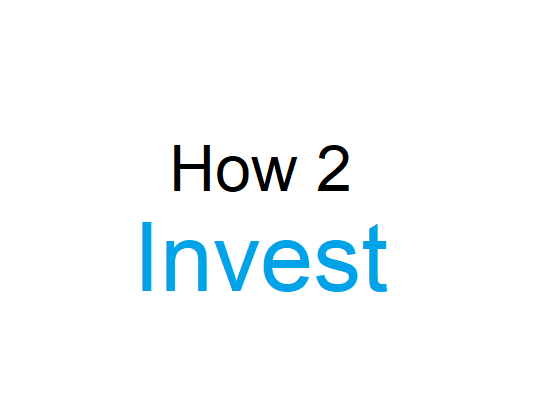How2invest In today’s complex financial landscape, knowing how to invest your hard-earned money wisely is a skill that can make all the difference in securing your financial future. This comprehensive guide is designed to provide you with the knowledge and insights you need to embark on a successful investment journey. Whether you’re a seasoned investor or just starting, understanding the fundamentals of investing, various investment options, and strategies is essential. So, let’s delve into the world of investments and learn how to make your money work for you.
1. How2Invest: A Beginner’s Guide
Starting Your Investment Journey
Investing is the art of making your money work for you, and it’s crucial for building wealth over time. But where do you start? Let’s explore the basics of how to invest and why it’s worth your time.
Figuring Out How2Invest
The first step in your investment journey is figuring out how2invest wisely. Platforms like How2Invest offer a comprehensive guide to investing. They provide tools to help you assess your financial goals, risk tolerance, and investment choices. By making informed decisions, you can set yourself up for success.
Opening an Investment Account
To begin investing, you’ll need to open an investment account, often called a brokerage account. Your choice of account depends on your preferences and financial goals. Tax-advantaged accounts like IRAs or standard brokerage accounts offer flexibility for different needs.
Understanding the Risks
It’s essential to acknowledge that all investments come with some level of risk. However, successful investing is about managing that risk effectively. This is where the basics of investing play a vital role.
2. Exploring Investment Options
Discovering a World of Investment Options
When it comes to investing, there’s no shortage of options to consider. From stocks and bonds to real estate and certificates of deposit, the world of investments is diverse and complex.
The Power of Diversification
Diversification is a fundamental investment strategy. It involves spreading your investments across various assets and asset classes to reduce the risk associated with individual investments. Diversification is your shield against the volatility of financial markets.
Investment Choices: Stocks, Collective Funds, and Exchange-traded fund
Investors often face the choice between creature stocks, collective funds, and exchange-traded funds (ETFs). Each option has its advantages and disadvantages. Stocks offer high potential returns but also higher risk. Mutual funds offer instant diversification, while ETFs provide flexibility and low costs.
Navigating Market Trends
Understanding market trends is essential for making informed investment decisions. Markets are influenced by economic indicators, geopolitical events, and industry-specific news. Staying informed about market trends can help you make timely investment choices.
3. Crafting Your Investment Strategy
Setting Clear Investment Goals
Before you start investing, it’s essential to define your financial goals. Are you aiming for long-term growth, such as retirement, or are your goals more short-term, like saving for a down payment on a house? Your investment strategy should align with your goals.
Long-Term vs. Short-Term Goals
Your time horizon plays a significant role in shaping your investment strategy. Investments for long-term goals may prioritize growth and include a higher proportion of stocks. Short-term goals may prioritize stability and regular interest payments.
Making Informed Decisions
Investing is not about trying to time the market but making smart financial decisions based on your risk tolerance and goals. A well-thought-out plan and discipline are key to successful investing.
4. The Power of Assortment
Building a Diversified Portfolio
Assortment is your secret weapon in the world of investing. By spreading your investments across different asset classes like stocks, bonds, and real estate, you can reduce the risk associated with any single investment.
Assessing Your Risk Tolerance
Your risk tolerance is a critical factor in determining the right level of assortment for your portfolio. It reflects how much risk you’re willing and able to endure without losing sleep at night. Your risk tolerance should align with your financial goals and investment Tips.
5. Understanding Risk Tolerance and Financial Goals
Aligning Risk Tolerance and Goals
Successful investing requires a careful balance between risk and reward. Your threat tolerance should align with your financial goals. If your goal is retirement, you may have a longer time horizon and a higher risk tolerance. Conversely, if your goals are less ambitious, you may prefer a more conservative approach.
The Role of an Investment Advisor
If you’re unsure about your threat tolerance or investment choices, consider seeking advice from a qualified investment advisor. An advisor can help you assess your financial situation, set realistic goals, and develop an investment tips tailored to your needs.
6. Different Asset Classes and You
Stocks or Bonds: Which Is Right for You?
Investors often grapple with the decision of whether to invest in stocks or bonds. Stocks offer the potential for higher returns but come with higher volatility. Bonds provide stability but typically offer lower returns. The mix of stocks and bonds in your portfolio should reflect your risk tolerance and financial objectives.
Exploring Real Estate Investment
Real estate can be an attractive option for diversifying your portfolio. It offers the potential for income through rental properties and property value appreciation. However, it also comes with its unique set of challenges and considerations.
7. Investing in Stocks, Mutual Funds, and ETFs
Choosing the Right Investment Vehicles
When it comes to investing in the stock market, you have various options, including individual stocks, mutual funds, and ETFs. Each option has its unique characteristics and benefits.
Individual Stocks
Investing in individual stocks means owning shares of specific companies. It offers the potential for significant returns but comes with higher risk, as your investment’s performance is tied to that company’s fortunes.
Mutual Funds and Exchange-traded fund
Mutual funds and Exchange-traded fund pool money from multiple investors to create diversified portfolios. They offer instant diversification, reducing the risk of individual stock picking. Mutual funds are actively managed, while ETFs typically track an index passively.
8. Real Estate Investment Insights
Delving into Real Estate
Investing in real estate can be an attractive option for further diversifying your portfolio. It can provide a source of regular income through rental properties and the potential for property value appreciation. However, it also comes with its set of tax rules and regulations that you need to understand.
9. The Role of an Investment Consultant
Navigating the Complex Investment Landscape
For those seeking expert guidance, an investment consultant can be a valuable resource. An advisor aims to provide you with tailored investment tips that help you achieve your financial Targets.
Paying for Advice
It’s important to note that investment consultant typically charge fees for their services. Be sure to understand the fee structure and how it aligns with your investment objectives.
You May Also Like :the Epic Saga: “Record of the Mightiest Lord” Chapter 1
10. Making Smart Financial Decisions
The Final Word on Successful Investing
In conclusion, How2invest embarking on a successful investment journey requires careful planning and consideration of various factors. It’s essential to understand your threat tolerance, set clear financial Targets, and choose investments that align with your objectives. Diversification and a well-thought-out investment tips are keys to building wealth over time. Whether you’re interested in stocks, bonds, mutual funds, ETFs, or real estate, there are options to suit your needs.
Remember that how2invest wisely is not about trying to time the market but about making informed decisions that align with your financial future. By following the advice in this comprehensive guide, you can take the first steps toward achieving your investment goals and securing your financial well-being. Visit Howsofar



